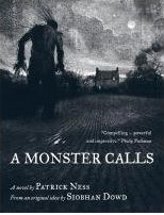A monster calls by Patrick Ness

Walker Books, 2011. ISBN 978 1 4063 1152 5
(Age: 10+) Highly recommended. Horror. Death.
From the start, the creeping menace of the Yew tree outside Conor's
window invades the imagination of the reader. The amazing
illustrations by Jim Kay storm through the book, evoking the shadow
world that the monster lives in, paralleling the world now inhabited
by Conor as he tries to care for his mother. The threat evoked
by the malice of the monster's presence is palpable, but Conor
derides its ability to make him cower in fear, as he knows something
far worse. He has lived with his nightmare for a while, waking at
12.07 each night with a thuddering heart and sick dread. His mother
sometimes stirs from her own disturbed sleep, vomitting in the
basin, or awake with the aftermath of chemotherapy.
In this phenomenal tale begun by the late Siobhan Dowd, and written
by Ness, we are treated to a superlative horror story, one that will
ensure that word of mouth impels its speed around any group of young
people from 10 to 15. Fenced in by the cancer which affects his
mother, Conor finds that he is invisible at school, his one time
friends avoid him, the bullies eventually giving up on him, bringing
his resentment to the surface. All the time, the monster calls at
12.07, telling his stories which impel him to action. His
destruction of his grandmother's front room brings no respite.
Beating up the bully, finds only compassion from the school, not
expulsion. Everywhere he turns he is pitied, not punished and it is
only with the last story that the monster makes him understand what
he has kept hidden from everyone else as well as from himself.
Death makes its way into every family and this is the story of how
one boy deals with it in the most extraordinary way, transferring
his feelings to the Yew Tree outside the house, using it as a prop
for his emotionally charged life, coping with an absent father, a
grandmother he does not care for, and ultimately his dying mother.
What began as a horror story, pulling in the reader through its
breathtaking illustrations and storytelling, ends as an acceptance
of the reality of death and the coming together of the boy and his
mother.
Fran Knight